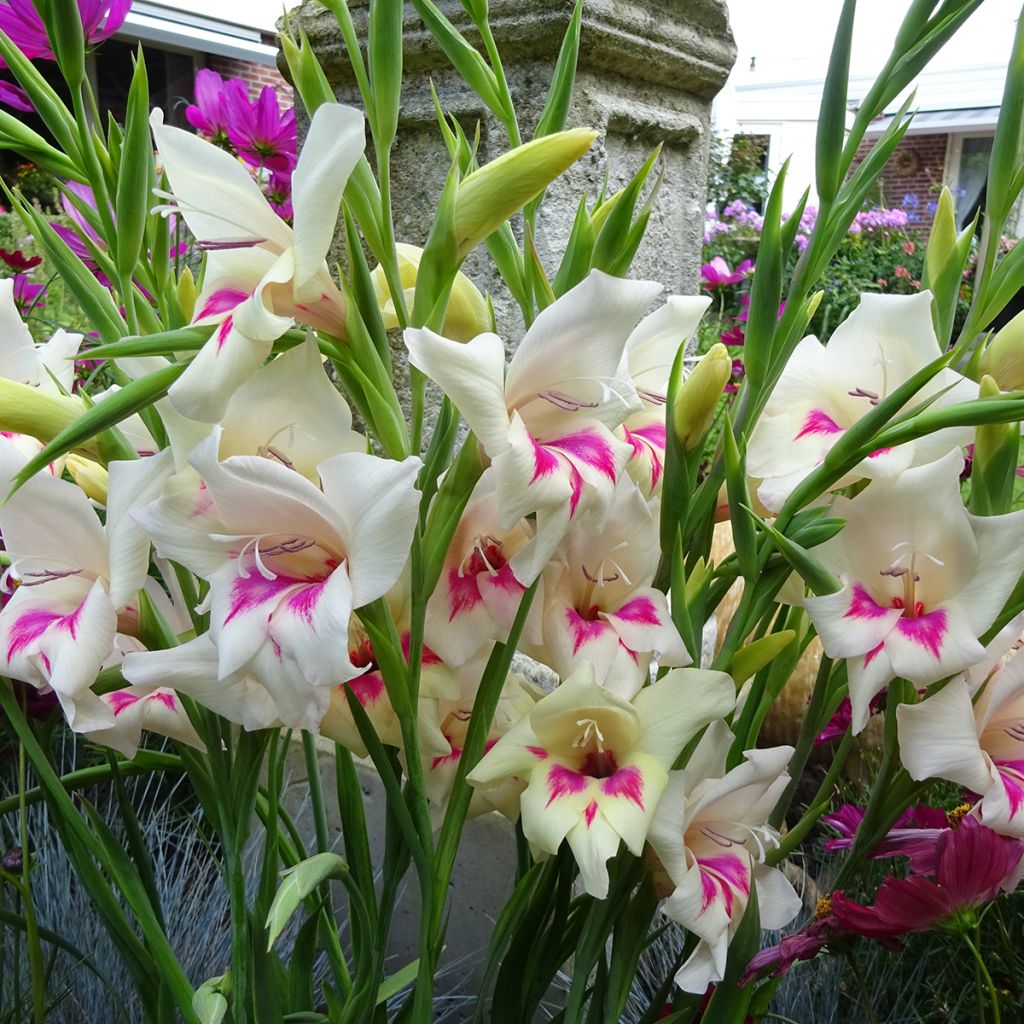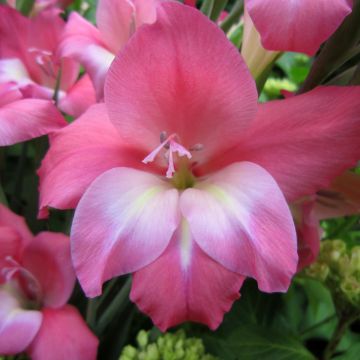

Gladiolus Carine - Sword Lily


Gladiolus Carine - Sword Lily
Gladiolus Carine - Sword Lily
Gladiolus x colvillei Carine
Colville's Gladiolus, Sword Lily
Special offer!
Receive a €20 voucher for any order over €90 (excluding delivery costs, credit notes, and plastic-free options)!
1- Add your favorite plants to your cart.
2- Once you have reached €90, confirm your order (you can even choose the delivery date!).
3- As soon as your order is shipped, you will receive an email containing your voucher code, valid for 3 months (90 days).
Your voucher is unique and can only be used once, for any order with a minimum value of €20, excluding delivery costs.
Can be combined with other current offers, non-divisible and non-refundable.
Home or relay delivery (depending on size and destination)
Schedule delivery date,
and select date in basket
This plant carries a 6 months recovery warranty
More information
We guarantee the quality of our plants for a full growing cycle, and will replace at our expense any plant that fails to recover under normal climatic and planting conditions.
Would this plant suit my garden?
Set up your Plantfit profile →
Description
Gladiolus 'Carine' is a compact variety of gladiolus, not exceeding 70 cm (28in) high. In late spring, the clump of long dark green leaves produces upright spikes carrying flower buds. These open into very beautiful cream-white flowers, adorned with a vibrant, rosy red marking, which gives them a special radiance. More hardy than the large classic hybrids, it can overwinter in the ground, under protective mulch. Its compactness eliminates the need for staking and allows it to be easily integrated into a mixed border, or even grown in a pot.
The Gladiolus genus belongs to the Iridaceae family, which mainly includes herbaceous plants. Many genera are prized for ornamental purposes, some are well-known, such as Crocuses or the large group of Irises and others are more obscure but equally captivating, such as Tigridia. There are more than 260 species of Gladiolus, with cultivated varieties being hybrids divided into three major groups: Grandiflorus (large-flowered), Primulinus (early-flowering), and Nanus (butterfly). Historically, the first hybrid created was Gladiolus x colvillei, obtained in England in 1823. It is a cross between Gladiolus cardinalis from South Africa, which grows on moist cliffs and along waterfalls, and G. tristis, from the same origin and with a lower habit.
Carine is a Dutch selection, obtained by the Van Winsen family in Warmond (north of The Hague). This Gladiolus from the dwarf group reaches only 70 cm (28in) high when flowering, with the clump of leaves measuring approximately 20 cm (8in) wide. The long and pointed, dark green leaves have a sword-like shape, which gives the plant its scientific name (in Latin, gladiolus actually means little sword). This foliage provides a perfect backdrop for the flowers, which contrast well against the dark leaves. Spikes for in late spring, each carrying 6 to 10 star-shaped flowers, 6 to 8 cm (2 to 3in) in diameter. The flowers are composed of three petals and three sepals that resemble each other so much that they are grouped together under the common name of tepals. They are a beautiful cream-white colour, and the lower tepals are adorned with a central spot whose colour ranges from fuchsia pink to carmine red. The flowers bloom in June and July, from the bottom of the spikes upwards. The storage organ is a corm, which is a swollen stem with scales. Each corm will produce 2 or 3 flower stalks. Plant them at intervals of two weeks from early spring to the end of June to have flowers in the house and garden all summer long.
The Carine gladiolus will even appeal to those who are resistant to the large classic hybrids, which may be criticised for their stiff and artificial appearance. This compact variety makes beautiful flowering pots for the terrace, while in the garden, it will be easy to combine with other ornamental plants, perennials, bulbs, and bushes, in a varied and sunny border. You can create a beautiful composition by growing it with the Moss Rose (Rosa centifolia Muscosa), which gets its name from the protrusions resembling moss that cover the branches and buds. Its delicately scented pink flowers have the incomparable charm of old roses and will create a romantic atmosphere alongside the Carine gladiolus. A carpet of Prunella webbiana Rosea will dress the edge of your border, and this low-growing perennial will reward you with its pink blooms throughout the summer. To extend the flowering season, consider Indian Lilacs, such as Lagerstroemia indica Houston with its compact and weeping habit, which from July to October produces dark pink, romantic flowers.
Report an error about the product description
Plant habit
Flowering
Foliage
Botanical data
Gladiolus
x colvillei
Carine
Iridaceae
Colville's Gladiolus, Sword Lily
Cultivar or hybrid
Other Gladioli
View all →Planting and care
Plant Carine Gladiolus bulbs in well-drained soil, in a sunny location sheltered from the wind under 8 to 10 cm (3 to 4in) of soil, 10 to 15 cm (4 to 6in) apart.
Colville Gladiolus loves rich, fertile, well-drained sandy soils and hates compact clay. Avoid using manure to fertilise the soil, as it promotes bulb rot. The plant should not lack water during its growth and flowering period, but its bulbs should be dry during the resting period. The corms of this variety can overwinter in the garden, in well-drained, very healthy soil, covered with a thick mulch to prevent damage from severe frost. In very cold regions, dig the plants up as soon as the leaves have turned yellow, to be stored dry, protected from heat and frost. You can also grow them in pots, protected from the cold (20 bulbs for a pot of 20 to 22 cm (8 to 9in)).
Planting period
Intended location
Care
This item has not been reviewed yet - be the first to leave a review about it.
Haven't found what you were looking for?
Hardiness is the lowest winter temperature a plant can endure without suffering serious damage or even dying. However, hardiness is affected by location (a sheltered area, such as a patio), protection (winter cover) and soil type (hardiness is improved by well-drained soil).

Photo Sharing Terms & Conditions
In order to encourage gardeners to interact and share their experiences, Promesse de fleurs offers various media enabling content to be uploaded onto its Site - in particular via the ‘Photo sharing’ module.
The User agrees to refrain from:
- Posting any content that is illegal, prejudicial, insulting, racist, inciteful to hatred, revisionist, contrary to public decency, that infringes on privacy or on the privacy rights of third parties, in particular the publicity rights of persons and goods, intellectual property rights, or the right to privacy.
- Submitting content on behalf of a third party;
- Impersonate the identity of a third party and/or publish any personal information about a third party;
In general, the User undertakes to refrain from any unethical behaviour.
All Content (in particular text, comments, files, images, photos, videos, creative works, etc.), which may be subject to property or intellectual property rights, image or other private rights, shall remain the property of the User, subject to the limited rights granted by the terms of the licence granted by Promesse de fleurs as stated below. Users are at liberty to publish or not to publish such Content on the Site, notably via the ‘Photo Sharing’ facility, and accept that this Content shall be made public and freely accessible, notably on the Internet.
Users further acknowledge, undertake to have ,and guarantee that they hold all necessary rights and permissions to publish such material on the Site, in particular with regard to the legislation in force pertaining to any privacy, property, intellectual property, image, or contractual rights, or rights of any other nature. By publishing such Content on the Site, Users acknowledge accepting full liability as publishers of the Content within the meaning of the law, and grant Promesse de fleurs, free of charge, an inclusive, worldwide licence for the said Content for the entire duration of its publication, including all reproduction, representation, up/downloading, displaying, performing, transmission, and storage rights.
Users also grant permission for their name to be linked to the Content and accept that this link may not always be made available.
By engaging in posting material, Users consent to their Content becoming automatically accessible on the Internet, in particular on other sites and/or blogs and/or web pages of the Promesse de fleurs site, including in particular social pages and the Promesse de fleurs catalogue.
Users may secure the removal of entrusted content free of charge by issuing a simple request via our contact form.
The flowering period indicated on our website applies to countries and regions located in USDA zone 8 (France, the United Kingdom, Ireland, the Netherlands, etc.)
It will vary according to where you live:
- In zones 9 to 10 (Italy, Spain, Greece, etc.), flowering will occur about 2 to 4 weeks earlier.
- In zones 6 to 7 (Germany, Poland, Slovenia, and lower mountainous regions), flowering will be delayed by 2 to 3 weeks.
- In zone 5 (Central Europe, Scandinavia), blooming will be delayed by 3 to 5 weeks.
In temperate climates, pruning of spring-flowering shrubs (forsythia, spireas, etc.) should be done just after flowering.
Pruning of summer-flowering shrubs (Indian Lilac, Perovskia, etc.) can be done in winter or spring.
In cold regions as well as with frost-sensitive plants, avoid pruning too early when severe frosts may still occur.
The planting period indicated on our website applies to countries and regions located in USDA zone 8 (France, United Kingdom, Ireland, Netherlands).
It will vary according to where you live:
- In Mediterranean zones (Marseille, Madrid, Milan, etc.), autumn and winter are the best planting periods.
- In continental zones (Strasbourg, Munich, Vienna, etc.), delay planting by 2 to 3 weeks in spring and bring it forward by 2 to 4 weeks in autumn.
- In mountainous regions (the Alps, Pyrenees, Carpathians, etc.), it is best to plant in late spring (May-June) or late summer (August-September).
The harvesting period indicated on our website applies to countries and regions in USDA zone 8 (France, England, Ireland, the Netherlands).
In colder areas (Scandinavia, Poland, Austria...) fruit and vegetable harvests are likely to be delayed by 3-4 weeks.
In warmer areas (Italy, Spain, Greece, etc.), harvesting will probably take place earlier, depending on weather conditions.
The sowing periods indicated on our website apply to countries and regions within USDA Zone 8 (France, UK, Ireland, Netherlands).
In colder areas (Scandinavia, Poland, Austria...), delay any outdoor sowing by 3-4 weeks, or sow under glass.
In warmer climes (Italy, Spain, Greece, etc.), bring outdoor sowing forward by a few weeks.

































